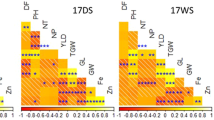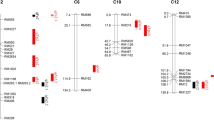Abstract
Identifying iron- and zinc-related quantitative trait loci (QTL) with consistent effects across environments and genetic backgrounds is necessary to develop rice varieties with high grain iron content (GIC) and grain zinc content (GZC). In this work, a doubled haploid population was developed through a cross between the Korean japonica cultivars Goami 2 and Hwaseonchal and phenotyped during the 2018 wet season (POP2018) and 2019 wet season (POP2019). The milled rice grains of POP2018 and POP2019 were used to identify GIC- and GZC-related QTL that was consistent between years. Digenic interactions and genes that affected GIC and GZC were also identified. Paired sample t test revealed that the GIC of POP2018 was not significantly different from that of POP2019 (t = 0.24, p =0.81), whereas the GZC of POP2018 was significantly different from that of POP2019 (t = − 4.35, p =0.00). Three moderate-effect (phenotypic variance [PVE] < 10.00%) GIC- and GZC-related QTL that were consistent between POP2018 and POP2019 were identified through inclusive composite interval mapping: qFe9, qFe11, and qZn7. All three QTL originated from the inferior parent Hwaseonchal. Epistasis analysis revealed that the GIC and GZC of POP2018 and POP2019 were affected by 79 significant digenic interactions with moderate and minor effects. By contrast, GZC was unaffected by digenic interactions. An interaction between loci on chromosomes 1 and 5 provided the highest contribution to the PVE (13.72%) for GIC. Candidate gene analysis revealed that 12 genes related to iron and zinc homeostasis or that require iron or zinc as ligands colocated with qFe9, qFe11, and qZn7. The QTL and epistatic regions identified here may be useful for developing rice varieties with high GIC and GZC in their milled grains.



Similar content being viewed by others
References
Anandan A, Rajiv G, Eswaran R, Prakash M (2011) Genotypic variation and relationships between quality traits and trace elements in traditional and improved rice (Oryza sativa L.) genotypes. J Food Sci 76(4):122–130
Bouis H, Welch R (2010) Biofortification—A sustainable agricultural strategy for reducing micronutrient malnutrition in the global south. Crop Sci 50:20–32
Choo TM, Reinberg E (1982) Analysis of skewness and kurtosis for detecting gene interaction in a double haploid population. Crop Sci 22:231–235
Descalsota GIL, Swamy BPM, Zaw H, Inabangan-Asilo MA, Amparado A, Mauleon R, Chadha-Mohanty P, Arocena EC, Raghavan C, Leung H, Hernandez JE, Lalusin AB, Mendioro MS, Diaz MGQ, Reinke R (2018) Genome-wide association mapping in a rice MAGIC plus population detects QTLs and genes useful for biofortification. Front Plant Sci 9:1–20
Descalsota-Empleo GI, Amparado A, Inabangan-Asilo MA, Tesoro F, Stangoulis J, Reinke R, Swamy BPM (2019) Genetic mapping of QTL for agronomic traits and grain mineral elements in rice. Crop J 7:560–572
Dixit S, Singh UM, Abbai R, Ram T, Singh VK, Paul A, Virk PS, Kumar A (2019) Identification of genomic region(s) responsible for high iron and zinc content in rice. Sci Rep 9(1):1–8
Garcia-Oliveira AL, Chander S, Ortiz R, Menkir A, Gedil M (2018) Genetic basis and breeding perspectives of grain iron and zinc enrichment in cereals. Front Plant Sci 9:1–13
Hu BL, Huang DR, Xiao YQ, Fan YY, Chen DZ, Zhuang JY (2016) Mapping QTLs for mineral element contents in brown and milled rice using an Oryza sativa × O. rufipogon backcross inbred line population. Cereal Res Commun 44:57–68
Inabangan-Asilo MA, Swamy BM, Amparado AF, Descalsota-Empleo GIL, Arocena EC, Reinke R (2019) Stability and G × E analysis of zinc-biofortified rice genotypes evaluated in diverse environments. Euphytica 215:1–17
Jeong OY, Lee JH, Jeong EG, Chun AR, Bombay M, Ancheta M, Anh SA (2020) Analysis of QTL responsible for grain iron and zinc content in doubled haploid lines of rice (Oryza sativa L.) derived from an intra-japonica cross. Plant Breed. https://doi.org/10.1111/pbr.12787
Kawahara Y, de la Bastide M, Hamilton JP, Kanamori H, Mc Combie WR et al (2013) Improvement of the Oryza sativa Nipponbare reference genome using next generation sequence and optical map data. Rice 6(1):1–10
Kennedy G, Burlingame B, Nguyen N (2002) Nutrient impact assessment of rice in major rice-consuming countries. Int Rice Comm Newsl 51:33–42
Laenoi S, Rerkasem B, Lordkaew S (2018) Seasonal variation in grain yield and quality in different rice varieties. Field Crops Res 221:350–357
Liao CY, Wu P, Hu B, Yi KK (2001) Effects of genetic background and environment on QTLs and epistasis for rice (Oryza sativa L.) panicle number. Theor Appl Genet 103:104–111
Lu K, Li L, Zheng X, Zhang Z, Mou T, Hu Z (2008) Quantitative trait loci controlling Cu, Ca, Zn, Mn, and Fe content in rice grains. J Genet 87:305–310
Maganti S, Swaminathan R, Parida A (2019) Variation in iron and zinc content in traditional rice genotypes. Agric Res. https://doi.org/10.1007/s40003-019-00429-3
Meng L, Li H, Zhang L, Wang J (2015) QTL IciMapping: integrated software for genetic linkage map construction and quantitative trait locus mapping in biparental populations. Crop J 3(3):269–283
Nriagu J (2011) Zinc deficiency in human health. Encyclopedia of environmental health. Elsevier, Amsterdam, pp 789–800
Oliver MA, Gregory PJ (2015) Soil, food security and human health. Eur J Soil Sci 66:257–276
PBTools (2014) Biometrics and breeding informatics, version 1.4. International Rice Research Institute, Los Banos
Pereira MP, Santos C, Gomes A, Vasconcelos MW (2014) Cultivar variability of iron uptake mechanisms in rice (Oryza sativa L.). Plant Physiol Biochem 85:21–30
Piccoli NB, Grede N, de Pee S, Singhkumarwong A, Roks E, Moench-Pfanner R, Martin WB (2012) Rice fortification: its potential for improving micronutrient intake and steps required for implementation at scale. Food Nutr Bull 33(4_suppl 3):S360–S372
Pooni HS, Jinks JL, Cornish MA (1977) The causes and consequences of non-normality in predicting the properties of recombinant inbred lines. Heredity 38:329–338
Samak NA, Hittalmani S, Shashidhar N, Biradar H (2011) Exploratory studies on genetic variability and genetic control for protein and micronutrient content in F4 and F5 generation of rice (Oryza sativa L.). Asian J Plant Sci 10(7):376–379
Stangoulis JC, Huynh BL, Welch RM, Choi EY, Graham RD (2007) Quantitative trait loci for phytate in rice grain and their relationship with grain micronutrient content. Euphytica 154:289–294
STAR (2014) Biometrics and breeding informatics version 2.0.1. International Rice Research Institute, Los Banos
Suwarto N (2011) Genotype × environment interaction for iron concentration of rice in central Java of Indonesia. Rice Sci 18(1):75–78
Swamy BPM, Descalsota GIL, Nha CT, Amparado A, Inabangan-Asilo MA, Manito C, Tesoro F, Reinke R (2018) Identification of genomic regions associated with agronomic and biofortification traits in DH populations of rice. PLoS One 13(8):1–20
UniProt Consortium (2018) UniProt: a worldwide hub of protein knowledge. Nucleic Acids Res 47(Database issue):D506–D515
Xu Q, Zheng TQ, Hu X, Cheng LR, Xu JL, Shi YM, Li ZK (2015) Examining two sets of introgression lines in rice (Oryza sativa L.) reveals favorable alleles that improve grain Zn and Fe concentrations. PLoS One 10(7):1–18
Zhang GM, Zheng TQ, Chen Z, Wang YL, Wang Y, Shi YM et al (2018) Joint exploration of favorable haplotypes for mineral concentrations in milled grains of rice (Oryza sativa L.). Front Plant Sci 9:1–14
Acknowledgements
This work was supported by a Grant from the Rural Development Administration, the Republic of Korea, and the International Rice Research Institute (Project title: The Germplasm Utilization for Value-Added Traits of Japonica Rice Phase II, Project No.: PJ01210101).
Author information
Authors and Affiliations
Contributions
OYJ, MB, and JHL: conceived and designed the experiments; OYJ and MB: performed the experiments; OYJ, MB, SMJ, and JHL: analyzed the data and wrote the manuscript.
Corresponding author
Ethics declarations
Conflict of interest
The authors declare that the research was conducted in the absence of any commercial or financial relationships that could be interpreted as a potential conflict of interest.
Electronic supplementary material
Below is the link to the electronic supplementary material.
Rights and permissions
About this article
Cite this article
Jeong, OY., Bombay, M., Jo, S. et al. QTL for the iron and zinc contents of the milled grains of a doubled-haploid rice (Oryza sativa L.) population grown over two seasons. J. Crop Sci. Biotechnol. 23, 291–299 (2020). https://doi.org/10.1007/s12892-020-00037-6
Accepted:
Published:
Issue Date:
DOI: https://doi.org/10.1007/s12892-020-00037-6




